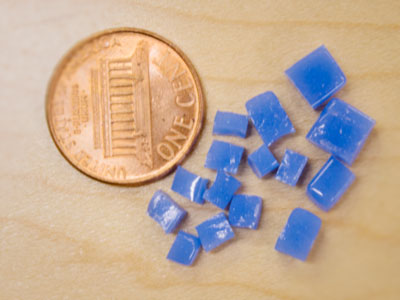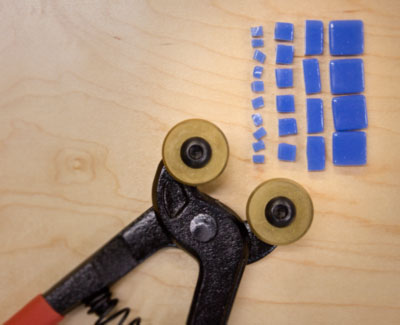Micromosaic is merely mosaic which is made from small to extremely small pieces of tile. Note that there isn’t a formal definition of how small the pieces need to be in order for a mosaic to be classified as micromosaic, but some of the better Roman examples are small mosaic insets in brooches and rings (with a level of detail best described as ridiculous), so be careful throwing the term around lightly.

Glass is the material of choice for true micromosaic. Of course other types of material could be used in theory, but for all practical purposes, only glass can be cut so small and still produce stable tesserae resistant to crumbling or fracturing. (When stone and most ceramic materials are cut very small using compression tools such as nippers, they tend to produce pieces that are easily broken by handling.)
Arranging a micromosaic design isn’t too difficult provided you use a pair of tweezers and have reasonably steady hands, but what has always made this medium prohibitively difficult in my opinion was the amount of labor required to produce the tesserae. Even with glass, most of the pieces produced by nipping would be useless slivers or dust. It didn’t matter what I tried (smalti, stained glass, vitreous, etc), it was always the same. The only thing I produced was frustration and a pile of splinters and bleeding fingers.
Then I discovered “pate de verre” or “enamel glass.” This type of glass is made by fusing glass powder with metal oxide pigments at temperatures lower than what is normally used for most types of glass, which are formed by a more complete melting of larger grains of material at a higher temperature. For this reason, enamel glass is sometimes called “warm glass.”
In terms of how well the glass cuts, the lower temperature of fusing isn’t what makes enamel glass different; the powdered state of the starting ingredients is, and the difference is profound. Enamel glass cuts cleanly and predictably without a lot of random breaks and shards because the microstructure of the material is very homogeneous (similar throughout). Unlike stained glass, there aren’t any cold seams and random swirls of heterogeneous (dissimilar) materials that cause the glass to fracture in unintended ways. Instead, enamel glass can be cut into tiny pieces with little waste and almost no glass dust.
That is why we are now selling the 12mm Elementile brand glass tile and recommending it as our material of choice for micromosaic art. It gets even better: The 12mm Elementile is our most affordable tile, our most complete color palette, and it is made from recycled glass! What’s not to love?


Leave a Reply